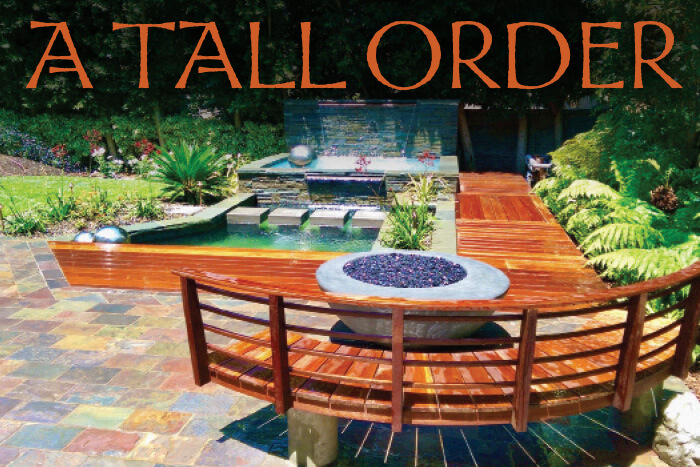There’s a common saying about having to hike uphill to and from school or work, enduring a tough trek without the help of modern conveniences.
Mike Garcia, sustainability expert and founder of Enviroscape LA Landscapes, Redondo Beach, California, put his crew’s toughness to the test with a recent hardscape and pond project that required a lot of hand-digging and climbing flights of stairs with loads of dirt. Although his crew might have felt like this project required them to trek uphill both ways, the result gave his clients the feeling of walking on water
Garcia, who has been a landscape contractor for 40 years, got his start gardening and mowing lawns in high school. He moved on to get his degree in ornamental horticulture. As he developed his business, he started to notice that he got better results with his work when using fewer chemicals and focusing on developing the entire landscape with a view toward permaculture.
That practice continues into his current projects, where he works on landscaping and hardscaping elements that blend and support each other, he says.
Finding ways to connect those different parts of the landscape requires having a solid understanding of what each piece entails. That’s especially true when working with hardscaping and a pond.
“There’s nothing more relaxing than to have a koi pond, but I really have to qualify what people really want,” he says. “You really have to know your definitions and be on your game.”
Garcia had worked with these clients in the past doing landscape work before they started working through the idea of installing a koi pond to offset a high-stress job. A structured, natural space could help relieve some stress without the need for blood pressure medication. It only made sense to start the conversation with Garcia.
Looking for cues
Finding the right hardscaping and pond design wasn’t as easy as just ordering off a menu. It’s more similar to going to get a haircut, he says, where a seasoned professional works on their craft every day. When customers come in, they often know what they want, but they don’t know the same jargon or technical work that goes into that. “All this language, it’s just meaningless to them,” Garcia says. Starting with reference pictures will get you much further along in both situations, whether you’re looking for an inviting outdoor living space or a mohawk.
It also gives you visual cues that are useful in determining exactly what the client is really after, he says. “When you see a picture, you resonate with it,” he says. “You can see the look in their eyes, when they light up. That’s when you know you’re on the right path.”
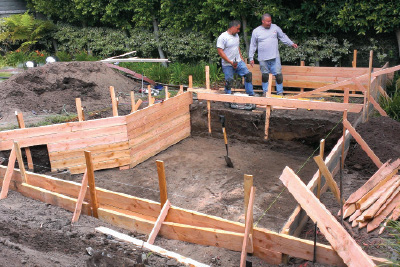
This is one area where new technology has helped, as Garcia used to bring about 10 albums of images to client meetings to gauge reactions, he says. There are no shortcuts to getting at what the client is after. It takes time to work with a client to get the guidelines for the design and field experience to be able to explain what’s involved in getting the project to that point.
The clients were looking for an immersive experience, where a visitor could get the sense of walking over the water’s surface. As they talked about the hardscape and pond design, the clients spent time looking through images and visited public spaces to get more ideas for what they wanted in their backyard. The house had more of a modern interior, so a full organic design would look out of place, Garcia says. “They were looking for a more modern, contemporary design.”
One of the tallest obstacles for the overall design was just height itself. From the street, the client’s house looks like a single-story design. But it actually extends down two more stories, with the backyard set on the lowest floor. The space had no outdoor or vehicle access from neighboring yards, blocked by concrete. The only point of access was through three stairwells leading back up to street level. That meant that all the materials had to be carried by hand down to the job site, and all the removed soil had to be carried up and out.
“There’s literally no way to get machinery or a Bobcat back there,” Garcia says. “You have no idea how heavy soil is until you’ve got to carry about 30 cubic yards of it up three flights of stairs.”
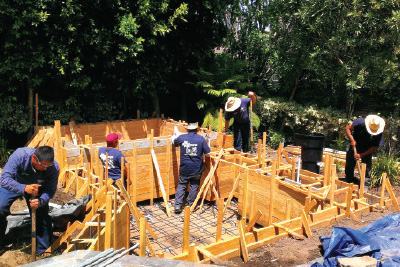 The team had to dig by hand, then carry the 5-gallon buckets across the yard, up three flights of stairs through the house, to the front yard and the bin in the street, he says.
The team had to dig by hand, then carry the 5-gallon buckets across the yard, up three flights of stairs through the house, to the front yard and the bin in the street, he says.
“It would’ve been nice to have a helicopter,” he jokes.
Taking on a project with these kinds of restrictions wasn’t going to be an easy sell to his crew, but Garcia stayed in touch with his employees and made plans to make sure they would be up to the task. The work wasn’t set to be done during the hottest part of the summer, and the cooler temperatures made the work a little bit more manageable. He also scheduled the project to have work done every few days rather than every single day to stagger the heavy work out and give the crew time to recover. The lunches provided on tough days didn’t hurt, either.
“You just don’t want to wear your guys out because they’re human,” he says. “They appreciate knowing that you have their back.”
An interactive design
The actual design of the koi pond and hardscaping was done by putting Garcia’s past experience to work, using the sketched-out plans from the clients. “The customer had a lot of faith in what was going in,” he says. They wanted a unique, interactive experience that brought a visitor up close to the water. That lined up with Garica’s usual approach of incorporating water in his landscape and hardscaping spaces. “Any time you do a water feature, you want it to be ‘in your face.’ You want it to be as interactive as possible and as close to the house as possible. You want your client to interact with it,” he says. “This case is more art than just building a box, so it made it more challenging.”
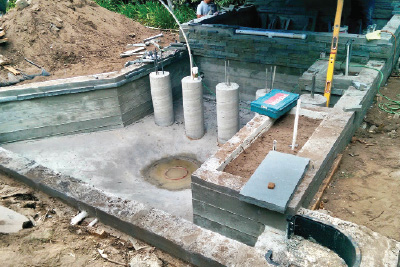 Garcia used tile and stone to frame the pond, bringing the refined edges of a modern look to a natural view. But the design stayed connected to more organic roots, with uneven facing of the blocks making up the walls of the pond and waterfall. “Having it unfinished gave it an earthiness,” he says. Another part of the pond’s framework incorporates wood patio flooring to bring another texture in. The hardscaping became one of the most interactive elements with a series of square stepping stones almost at water height across the pond, bringing the visitor up close and personal with the resident koi and the series of waterfalls.
Garcia used tile and stone to frame the pond, bringing the refined edges of a modern look to a natural view. But the design stayed connected to more organic roots, with uneven facing of the blocks making up the walls of the pond and waterfall. “Having it unfinished gave it an earthiness,” he says. Another part of the pond’s framework incorporates wood patio flooring to bring another texture in. The hardscaping became one of the most interactive elements with a series of square stepping stones almost at water height across the pond, bringing the visitor up close and personal with the resident koi and the series of waterfalls.
The top pond and waterfall are completely ornamental as a backdrop, he says.
The lower pond is four feet deep and has filtration to keep the water clear and the koi happy. Garcia chose tile and stonework that would react and emphasize their color when wet, given the close proximity to the water.
“That gives it some wow factor. Anybody can dig a hole and throw in a liner and put some water down,” he says. “They pay you to be an artist, so this is art.”
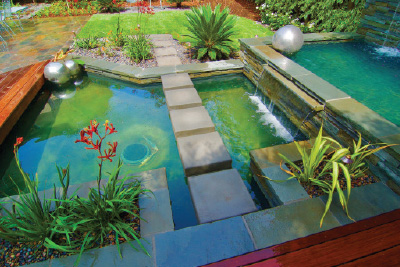
The design incorporates landscaping through several ornamental plants and flowers brought to the water’s edge with the stonework. It also meant being conscious of a neighbor’s set of hedges nearby. The pond had to be placed far enough away so that when the hedge was trimmed, clippings wouldn’t fill either pond and require cleaning.
“I’ve seen jobs where they put these right up next to hedges,” Garcia says. “You have to think about things like future maintenance.”
Garcia’s design kept a small patch of grass nearby as well as a place for the client’s small dog, but he wanted to approach it with a water-conscious focus, he says. The space is irrigated using dripline to keep water usage well within the region’s restrictions and to make certain the water is applied precisely where he wanted it.
In the end, Garcia’s team won an award from the California Landscape Contractors Association for the project.
Planning ahead
Hardscaping work can be difficult because it’s easy for contractors to shortchange themselves for the amount of work that’s being done, Garcia says. For a project like a hardscaped pond and outdoor living space, a contractor needs to remember every step of the work that needs to be completed and think of the cost.
“You’ve got to understand, you need guys to dig that hole and move the soil,” he says.
That means making sure early in the process that the client is aware of the potential cost of the project and is able to afford it, he says. That’s part of making sure the client knows what comes with a hardscaped outdoor living space, especially with a water feature involved.
“It’s very important to educate your client on expectations,” Garcia says. “I always tell people that algae will happen, fish will die. But you have to tell them so they don’t set up false expectations.”
Making certain that clients know how to maintain the living space and features will help them enjoy the project for years to come and help you keep them as a longterm client as well.

